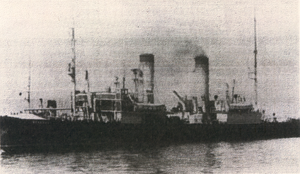Lenin (icebreaker)

The icebreaker Lenin, former St. Alexander Nevsky.
|
|
| History | |
|---|---|
|
|
|
| Name: | HMS Alexander |
| Builder: | Armstrong Whitworth, Newcastle upon Tyne, England |
| Yard number: | A/W 905 |
| Laid down: | June 1916 |
| Launched: | 23 December 1916 |
| Completed: | June 1917 |
| Commissioned: | September 1917 |
| Decommissioned: | 1919 |
| Fate: | Handed over to White Russian forces, 1919 |
|
|
|
| Name: |
|
| Namesake: | Vladimir Lenin |
| Acquired: | c.1919 |
| Out of service: | 1968 |
| Fate: | Scrapped, 1977 |
| General characteristics | |
| Type: | Icebreaker |
| Tonnage: | 3,375 GRT |
Lenin (Russian: Ленин) was a Russian icebreaker originally built in England for the Russian Empire. Launched in 1916, before going into service for Russia, the ship first served in the Royal Navy during the Allied intervention in the Russian Civil War. It was eventually acquired by the Soviet Union and served through World War II, eventually being finally scrapped in 1977.
The ship, ordered by the Russian Empire, was laid down in June 1916 by Armstrong Whitworth at Newcastle upon Tyne as the St. Alexander Nevsky, after Russian statesman and military hero Alexander Nevsky. Her construction was supervised by Russian naval architect and author Yevgeny Zamyatin. The ship was launched on 23 December 1916, and completed in June 1917. By then though the Russian Empire had ceased to exist following the February Revolution, and the ship was requisitioned by the Royal Navy and commissioned as HMS Alexander in September 1917. Alexander served in the North Russia campaign, and was handed over to White Russian forces when the British withdrew in October 1919.
The ship must have been soon taken by the Bolsheviks, for in 1921 the Norwegian sailor and Arctic explorer Otto Sverdrup commanded the ship, now named Lenin, at the request of the Soviet government, when he mounted his fourth and last expedition in Arctic Siberian waters. He led a convoy of five cargo ships on an experimental run through the Kara Sea to the mouths of the Ob and Yenisei Rivers. The ships reached their destinations and returned safely. This was considered an important step in the development of the Kara Sea sector of the Northern Sea Route.
...
Wikipedia
